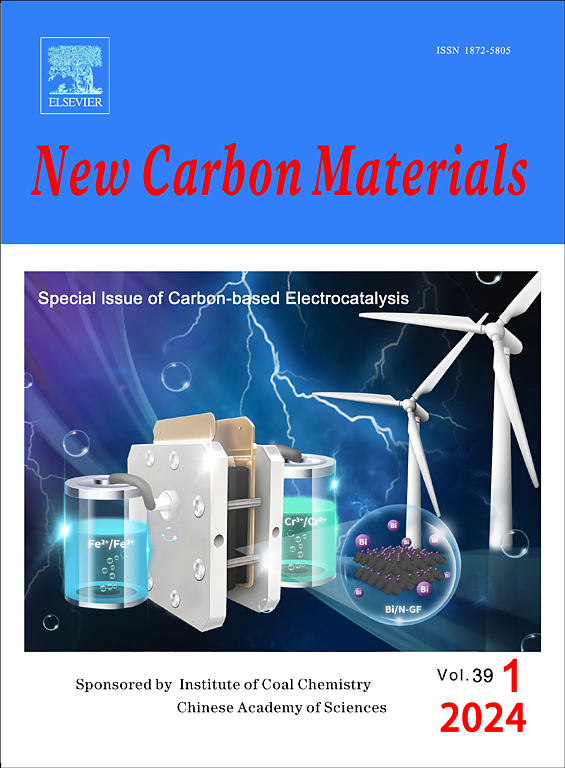Defect-rich N/O-co-doped porous carbon frameworks as anodes for superior potassium and sodium-ion batteries
IF 5.7
3区 材料科学
Q2 Materials Science
引用次数: 0
Abstract
Carbon with its high electrical conductivity, excellent chemical stability, and structure ability is the most promising anode material for sodium and potassium ion batteries. We developed a defect-rich porous carbon framework (DRPCF) built with N/O-co-doped mesoporous nanosheets and containing many defects using porous g-C3N4 (PCN) and dopamine (DA) as raw materials. We prepared samples with PCN/DA mass ratios of 1/1, 2/1 and 3/1 and found that the one with a mass ratio of 2/1 and a carbonization temperature of 700 °C in an Ar atmosphere (DRPCF-2/1-700), had a large specific surface area with an enormous pore volume and a large number of N/O heteroatom active defect sites. Because of this, it had the best pseudocapacitive sodium and potassium ion storage performance. A half battery of Na//DRPCF-2/1-700 maintained a capacity of 328.2 mAh g−1 after being cycled at 1 A g−1 for 900 cycles, and a half battery of K//DRPC-2/1-700 maintained a capacity of 321.5 mAh g−1 after being cycled at 1 A g−1 for 1 200 cycles. The rate capability and cycling stability achieved by DRPCF-2/1-700 outperforms most reported carbon materials. Finally, ex-situ Raman spectroscopy analysis result confirms that the filling and removing of K+ and Na+ from the electrochemically active defects are responsible for the high capacity, superior rate and cycling performance of the DRPCF-2/1-700 sample.
富缺陷N/ o共掺杂多孔碳框架用作优质钾钠离子电池阳极
碳具有高导电性、优异的化学稳定性和结构能力,是钠离子电池和钾离子电池最有前途的负极材料。以多孔g-C3N4 (PCN)和多巴胺(DA)为原料,利用N/ o共掺杂介孔纳米片构建了含有多种缺陷的富缺陷多孔碳骨架(DRPCF)。我们制备了PCN/DA质量比分别为1/ 1,2 /1和3/1的样品,发现质量比为2/1,在Ar气氛中碳化温度为700℃的样品(DRPCF-2/1-700)具有较大的比表面积、巨大的孔体积和大量的N/O杂原子活性缺陷位点。因此,它具有最佳的假电容性钠离子和钾离子存储性能。半电池Na//DRPCF-2/1-700在1 A g−1条件下循环900次后容量保持在328.2 mAh g−1,半电池K// DRPCF-2/1-700在1 A g−1条件下循环1200次后容量保持在321.5 mAh g−1。DRPCF-2/1-700实现的速率能力和循环稳定性优于大多数报道的碳材料。最后,非原位拉曼光谱分析结果证实,在电化学活性缺陷中填充和去除K+和Na+是DRPCF-2/1-700样品具有高容量、高倍率和高循环性能的原因。
本文章由计算机程序翻译,如有差异,请以英文原文为准。
求助全文
约1分钟内获得全文
求助全文
来源期刊

New Carbon Materials
MATERIALS SCIENCE, MULTIDISCIPLINARY-
CiteScore
6.10
自引率
8.80%
发文量
3245
审稿时长
5.5 months
期刊介绍:
New Carbon Materials is a scholarly journal that publishes original research papers focusing on the physics, chemistry, and technology of organic substances that serve as precursors for creating carbonaceous solids with aromatic or tetrahedral bonding. The scope of materials covered by the journal extends from diamond and graphite to a variety of forms including chars, semicokes, mesophase substances, carbons, carbon fibers, carbynes, fullerenes, and carbon nanotubes. The journal's objective is to showcase the latest research findings and advancements in the areas of formation, structure, properties, behaviors, and technological applications of carbon materials. Additionally, the journal includes papers on the secondary production of new carbon and composite materials, such as carbon-carbon composites, derived from the aforementioned carbons. Research papers on organic substances will be considered for publication only if they have a direct relevance to the resulting carbon materials.
 求助内容:
求助内容: 应助结果提醒方式:
应助结果提醒方式:


